Repotting Bonsai in the Fall: A Seasonal Guide
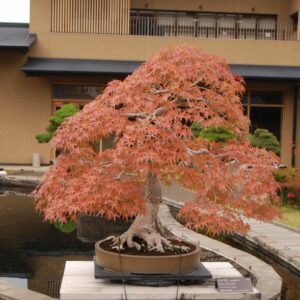
Why consider fall repotting?
Repotting bonsai in the fall can be a strategic move for maintaining the health and vitality of your miniature trees. There are several advantages to fall repotting.
Enjoy flowering
Flowering bonsai may benefit from fall repotting to avoid disrupting their blooming cycle. If these trees are repotted in the spring just before or during their blooming season, there’s a risk that the repotting disrupts the flowering process, potentially leading to a year without blossoms.
Prevent rose family disease
Fall repotting may prevent rose family diseases from spreading.
Rose family trees such as plum, cherry blossom, Chinese quince and apple are prone to a disease called bacterial crown gall that causes weakening, stunting, and diebacks in rose family bonsai trees. This bacteria lives in the soil and attacks the wounded sites, such as pruned roots.
As this bacteria thrives within a temperature range of 57° to 86°F (14° to 30°C), repotting those trees prone to this disease in the fall lowers the risk of infection and subsequent spreading.
Maintain tree health
In some cases, the bonsai’s root system may show signs of root rot or other issues that necessitate immediate attention. In such situations, waiting until spring may not be advisable, and fall repotting becomes a necessary intervention.
Is it OK to repot bonsai in the fall?
Repotting bonsai in fall is OK but the decision depends on various factors including the type of bonsai, your climate, and the specific condition of your tree. Here are some key points to consider:
Tree species
Determine if your bonsai species are well-suited for fall repotting. Some of the flowering/ fruiting and evergreen species can be candidates, but most of them are not if you want to make sure they survive the winter without special cold protection.
Tropical bonsai are better repotted in the spring or summer.
Tree health
Make sure your bonsai is in good health and has recovered from recent stressors such as summer heat. Healthy trees are better equipped to handle the stress of repotting.
Temperature
The average daily high and low temperatures should be suitable for repotting: daytime temperatures around 70°F (21°C) or higher and nighttime temperatures above 50°F (10°C).
You should avoid repotting if there’s any risk of an early frost after a month of repotting.
Healing time after repotting
Make sure there are several weeks to a month for the tree to heal after repotting before the onset of winter. The exact healing time varies depending on tree health, the extent of rootwork, and the local climate.
During this post-repotting period, the temperature should be relatively stable (not too warm or cold).
Weather forecast
Research the average first frost date in your region. You should repot well before this first frost date to avoid potential frost damage to newly repotted trees. Also, avoid repotting if there are any expected unseasonal cold temperatures in the near future.
Remember that the specific conditions for fall repotting can vary by region and tree species. It’s crucial to understand your local climate and the needs of your bonsai to determine if the conditions are right for a successful fall repotting.
What bonsai can be repotted in the fall?
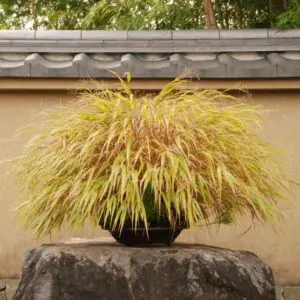
Kusamono (grass)
Not all bonsai trees are suited for repotting in the fall.
Some flowering/fruiting bonsai trees such as rose, cherry blossom, crabapple, pyracantha, and Chinese quince as well as some evergreen species such as Japanese black and white pines are known to tolerate fall repotting. But extra care is needed.
It’s important to note that certain species, like tropical bonsai, should not be repotted in the fall and it is always safer to repot in early spring for most of the bonsai tree species when the new buds start to grow.
Navigating September and October repotting
If you’ve decided that fall repotting is suitable for your bonsai tree, the next step is to carefully plan the process within the months of September and October. Let’s explore the considerations for repotting your bonsai during these autumn months.
Can I Repot my bonsai in September?
September can be an ideal month for fall repotting, if ever possible, as it often offers milder temperatures compared to October.
That said, monitor the weather forecast and avoid repotting during unusually hot or cold spells. Check also the monthly and long-range forecast to see when it gets colder this year and if an unusually cold winter is coming.
Can I repot bonsai in October?
Repotting in October is doable in regions with warmer climates but not recommended for most of the states in moderate and cooler climates. October is a month when fall is in full swing and the temperature can be quite cold for your bonsai to recover and prepare for winter.
But if you do decide to repot in October, take extra precautions to protect your bonsai from chilly nights. You can move it in the garage or place it in a sheltered area to shield it from the cold during winter.
US climate zones and repotting
The region where you live has a significant impact on whether or not you can successfully repot bonsai in the fall. Different regions of the United States experience varying temperature levels and climate conditions, which directly influence the feasibility of fall repotting.
There are 5 major climate zones in the mainland US;
-
- tropical,
- dry,
- moist subtropical mid-latitude,
- moist continental mid-latitude and
- highlands climates.

The major Köppen zones in the U.S.
(Source: National Weather Service)
Let’s explore the possibility of fall repotting with specific regions and temperature considerations.
1- Zone A (Tropical Climates)
Under tropical moist climates, all months have average temperatures greater than 64°F (18°C). For areas in this zone, fall repotting is feasible as temperatures often remain mild.
- Southern part of Florida
2- Zone B (Dry Climates)
In this warm but dry climate, fall repotting is possible but water management is the key after repottong.
-
- Arizona
- Nevada
- Texas (small portions in the west)
- California
3- Zone C (Moist Subtropical Mid-Latitude Climates)
Fall repotting is often suitable in this climate as it is characterized by mild winters. The relatively stable temperatures and moisture levels during the fall support the bonsai’s recovery after repotting.
-
- Florida
- Georgia
- Texas
4- Zone D (Moist Continental Mid-Latitude Climates)
Fall repotting can be considered but must be completed well before winter’s onset as winters are severe with snowstorms and strong winds. Also, you must have a cold protection facility (e.g. greenhouse).
-
- New York
- Pennsylvania
- Michigan
- Illinois
- Oregon (coastal areas)
- Washington (coastal areas)
- California (northern coastal regions)
5- Zone H (Highlands)
Fall repotting can be considered in early fall. This climate can experience rapid temperature changes, especially as fall progresses and colder temperatures are more likely in late fall.
Fall repotting process: A step-by-step guide
Repotting your bonsai in the fall requires a slightly different approach compared to spring repotting. In this section, I’ll walk you through the essential steps of the repotting process during the fall season.
Step 1: Pull the tree out and remove old soil
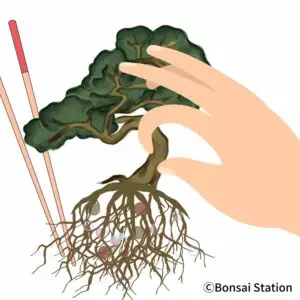
Remove the soil with a chopstick
Pull the tree out of the pot. Using a wooden chopstick, remove some of the old soil from the tree’s roots. Be gentile and do not take out a large portion of the old soil.
Step 2: Prune the roots
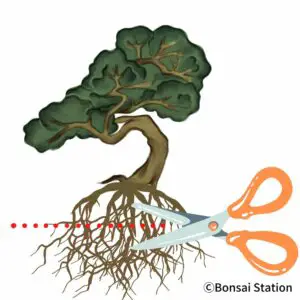
Prone the roots.
Root pruning in fall repotting should be as minimal as possible.
It is not only stressful to your tree but it also cuts off energy sources for winter survival. Nutrients produced during the growing season are preserved throughout the plant body but those stored in the roots are for emergencies, like in winter.
Step 3: Put some of the bonsai soil mix
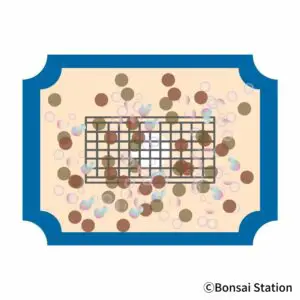
Put some of the soil mix.
Put a layer of large grain soil (eg. pumice) on the bottom of the pot for drainage. The new pot should NOT be smaller and/or shallower than the old pot, which usually needs hard root pruning.
Step 4: Position the tree and secure it with wire
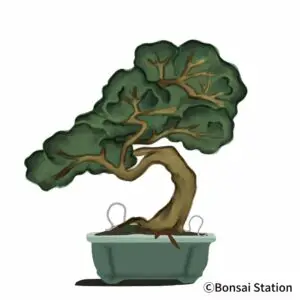
Secure the tree using wires/strings.
Carefully place the tree in the pot. Spread the roots evenly in every direction so that good surface roots (nebari) will be developed.
Secure the tree to the pot using wires/strings. The roots of the tree should be locked and immovable in the soil as new roots will not be regenerated if the root system is disturbed by wind or rain.
Step 5: Put the rest of the bonsai soil mix

Put the rest of the soil.
Hold the tree in place and put the rest of the bonsai soil mix in the pot. Use a wooden chopstick or a similar tool to gently push the soil into the air pockets. Add more soil and push the soil in between the roots. Repeat the process until all the gaps are filled.
For a more detailed guide to repotting, please check the following post.
Care after fall repotting

spruce
Once you’ve completed the fall repotting process, it’s essential to provide your bonsai with the right conditions and care to ensure a smooth transition.
Place in a sheltered location
After repotting, place your bonsai in a sheltered location. If it is still warm, it can be a partially shaded area with little wind.
Monitor temperature
Keep an eye on the local weather all the time. If it gets cold, move your bonsai to a more protected environment, such as an unheated garage or a cold frame, during the coldest nights.
Watering
Maintain the right soil moisture level. Newly repotted trees may not absorb water as much as before but still need water. And they should not be allowed to dry out completely or waterlogged.
It sounds difficult but monitor soil moisture level closely and water when the top layer of soil feels dry to the touch.
Protect from cold
When it is getting colder, your bonsai needs protection from cold for all winter. Repotting in the fall makes your bonsai more vulnerable to cold damage compared to not repotting it. It can be a sheltered area such as a garage or cold frame. It is essential to take precautions and protect it from the cold.
For more detailed information about overwintering, please check the following post.



